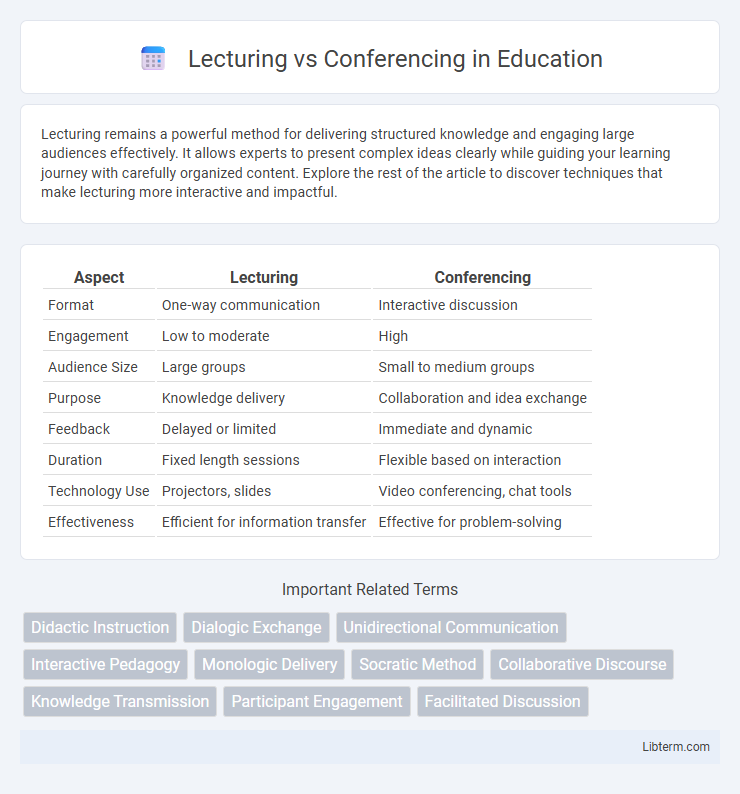Lecturing remains a powerful method for delivering structured knowledge and engaging large audiences effectively. It allows experts to present complex ideas clearly while guiding your learning journey with carefully organized content. Explore the rest of the article to discover techniques that make lecturing more interactive and impactful.
Table of Comparison
| Aspect | Lecturing | Conferencing |
|---|---|---|
| Format | One-way communication | Interactive discussion |
| Engagement | Low to moderate | High |
| Audience Size | Large groups | Small to medium groups |
| Purpose | Knowledge delivery | Collaboration and idea exchange |
| Feedback | Delayed or limited | Immediate and dynamic |
| Duration | Fixed length sessions | Flexible based on interaction |
| Technology Use | Projectors, slides | Video conferencing, chat tools |
| Effectiveness | Efficient for information transfer | Effective for problem-solving |
Understanding Lecturing and Conferencing
Lecturing involves a one-way flow of information where the speaker delivers structured content to an audience, often emphasizing clarity and depth of a specific subject. Conferencing facilitates interactive communication among participants, fostering collaborative discussion and real-time exchange of ideas to enhance collective understanding. Understanding lecturing and conferencing requires recognizing their distinct purposes: lecturing prioritizes knowledge transmission, while conferencing emphasizes engagement and dialogue.
Key Differences Between Lecturing and Conferencing
Lecturing involves a one-way communication where the instructor delivers information to a passive audience, emphasizing knowledge transfer and structured content. Conferencing centers on interactive dialogue, fostering collaboration, idea exchange, and active participation among attendees. Key differences include the direction of communication, engagement level, and purpose, with lecturing prioritizing instruction and conferencing emphasizing discussion.
Historical Evolution of Teaching Methods
The historical evolution of teaching methods reveals a shift from traditional lecturing, rooted in ancient oral traditions and formalized in medieval universities, to conferencing formats emphasizing interactive dialogue and collaborative learning. Lecturing dominated early education due to its efficiency in disseminating information to large groups, while conferencing emerged with progressive education movements seeking to foster critical thinking and student engagement. Advances in technology and pedagogical research have further transformed conferencing into dynamic platforms for personalized learning and real-time feedback.
Advantages of Lecturing in Education
Lecturing allows educators to efficiently deliver comprehensive information to large groups, promoting structured learning and clear knowledge dissemination. It fosters consistent content presentation, ensuring all students receive the same foundational material essential for standardized curriculum. Lecturing also enables educators to integrate multimedia tools, enhancing engagement and supporting various learning styles within a controlled environment.
Benefits of the Conferencing Approach
The conferencing approach enhances interactive learning by fostering real-time collaboration and immediate feedback between participants and instructors, improving comprehension and retention. It supports diverse communication methods such as video, chat, and screen sharing, which accommodate different learning styles and increase engagement. This dynamic environment encourages active participation, critical thinking, and peer-to-peer knowledge exchange, leading to deeper understanding and more meaningful educational experiences.
Suitability for Diverse Learning Environments
Lecturing suits large, homogenous groups by delivering standardized content efficiently, while conferencing supports interactive, personalized learning ideal for diverse and small settings. Conferencing adapts to varied learning styles and encourages collaboration, making it effective in inclusive classrooms with different skill levels. Educators often combine both to balance content mastery with critical thinking and engagement across diverse learners.
Engagement and Interaction: A Comparative Analysis
Lecturing often limits student engagement due to its one-way communication format, whereas conferencing fosters dynamic interaction by encouraging dialogue and immediate feedback. Engagement in conferencing is typically higher as participants actively contribute, ask questions, and collaborate, enhancing comprehension and retention. Research shows interactive sessions in conferencing increase learner motivation and facilitate deeper understanding compared to traditional lecturing.
Technological Impacts on Lecturing and Conferencing
Technological impacts have transformed lecturing and conferencing by enabling real-time interaction through digital platforms like Zoom and Microsoft Teams, enhancing accessibility and participation globally. Advanced tools such as AI-driven transcription and virtual whiteboards improve content delivery and engagement during lectures and conferences. Integration of augmented reality and immersive technologies further enriches learning experiences by simulating real-world scenarios and collaborative environments.
Choosing the Right Method for Your Audience
Selecting between lecturing and conferencing depends on your audience's learning style, engagement level, and the topic complexity. Lecturing suits large groups needing structured delivery of expert knowledge, while conferencing excels with smaller, interactive sessions encouraging collaboration and idea exchange. Tailoring the method to audience preferences enhances comprehension, participation, and knowledge retention.
Future Trends in Educational Delivery Methods
Lecturing is evolving with the integration of interactive technologies, promoting active learning and real-time feedback, while conferencing platforms are increasingly leveraging AI-driven analytics to personalize educational experiences. Future trends emphasize hybrid models that combine asynchronous lecturing content with synchronous conferencing to enhance engagement and accessibility. Adaptive learning algorithms and immersive virtual environments will further transform educational delivery by catering to diverse learner needs and fostering collaborative knowledge construction.
Lecturing Infographic

 libterm.com
libterm.com